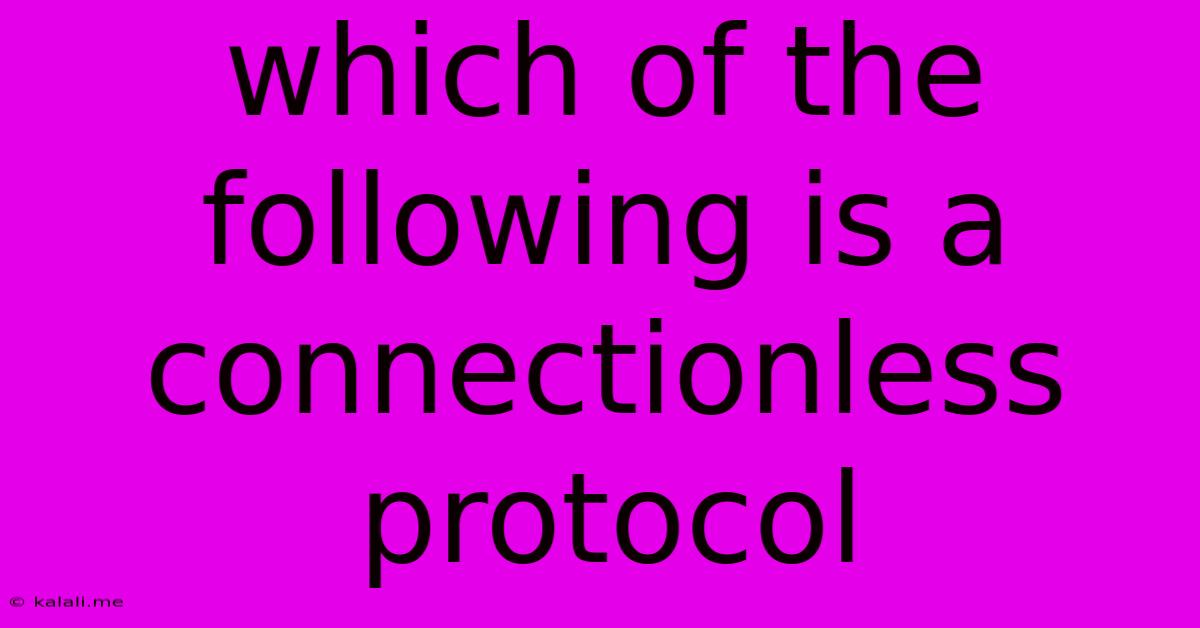Which Of The Following Is A Connectionless Protocol
Kalali
Jun 14, 2025 · 3 min read

Table of Contents
Which of the Following is a Connectionless Protocol? Understanding Network Protocols
This article will delve into the world of network protocols, specifically focusing on connectionless protocols. We'll explore what makes a protocol "connectionless," compare it to connection-oriented protocols, and provide clear examples to help you understand the key differences. This is crucial knowledge for anyone working with networks, from IT professionals to aspiring developers.
What is a Connectionless Protocol?
A connectionless protocol is a type of network protocol that doesn't establish a dedicated connection between the sender and receiver before transmitting data. Instead, each data packet is transmitted independently, without prior arrangement or a guaranteed delivery. Think of it like sending postcards – you write the address, drop it in the mail, and hope it arrives. There's no confirmation that the recipient received it, and if it gets lost, you wouldn't know. This contrasts sharply with connection-oriented protocols, which are like making a phone call – you establish a connection, have a conversation, and then hang up.
Key Characteristics of Connectionless Protocols:
- No Connection Establishment: Data packets are sent individually without prior setup.
- Independent Packet Transmission: Each packet is treated separately; the loss of one doesn't affect others.
- Faster Transmission: Because there's no connection handshake, transmission is generally quicker.
- Less Overhead: Less data is needed for setup and control information.
- Unreliable Delivery: There's no guarantee that all packets will arrive or arrive in order.
- Best-Effort Delivery: The network tries its best to deliver packets, but there's no guarantee.
Connectionless vs. Connection-Oriented Protocols: A Comparison
| Feature | Connectionless Protocol | Connection-Oriented Protocol |
|---|---|---|
| Connection Setup | No | Yes |
| Data Transmission | Independent packets | Ordered stream of data |
| Reliability | Unreliable | Reliable |
| Speed | Faster | Slower |
| Overhead | Lower | Higher |
| Error Handling | None (packets may be lost or reordered) | Built-in error detection and correction |
| Examples | UDP, IP | TCP, SSL/TLS, FTP |
Examples of Connectionless Protocols:
-
User Datagram Protocol (UDP): Widely used for applications where speed and low latency are prioritized over reliability, such as online gaming, video streaming (often in conjunction with other protocols for error correction), and DNS lookups. It's efficient but doesn't guarantee delivery.
-
Internet Protocol (IP): The fundamental protocol of the internet, responsible for addressing and routing packets. While it handles addressing and routing, it itself is connectionless, relying on protocols like TCP or UDP for reliable data transfer.
Choosing the Right Protocol:
The choice between a connectionless and connection-oriented protocol depends on the application's requirements. If reliability is paramount, a connection-oriented protocol is necessary. However, if speed and efficiency are more critical, even with the risk of data loss, a connectionless protocol is a better choice. Many applications use a combination of both types of protocols to optimize performance and reliability.
In Conclusion:
Understanding the differences between connectionless and connection-oriented protocols is essential for anyone involved in networking. Knowing that UDP and IP are prime examples of connectionless protocols will help you make informed decisions when designing or troubleshooting network applications. The specific needs of the application – prioritizing speed versus reliability – will ultimately dictate the best choice of protocol.
Latest Posts
Latest Posts
-
For The Function F For Each Increase
Jun 14, 2025
-
Which Of The Following Species Has The Largest Radius
Jun 14, 2025
-
Chemicals That Resist Changes In Ph Are Called
Jun 14, 2025
-
What Is The Least Common Multiple Of 3 4 5
Jun 14, 2025
-
What Is Not A Primary Colour
Jun 14, 2025
Related Post
Thank you for visiting our website which covers about Which Of The Following Is A Connectionless Protocol . We hope the information provided has been useful to you. Feel free to contact us if you have any questions or need further assistance. See you next time and don't miss to bookmark.